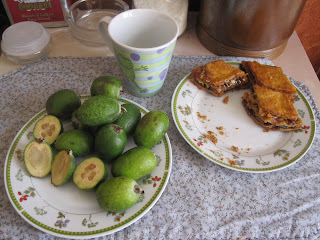 |
| Making yummies.. khinkalis are on the menu. |
The women:
Intelligent and somewhat repressed women, at least by Western standards. All of them dark-haired, with beautiful, thick and straight hair. The majority is between 5’2” and 5’6”.Most of them educated in some professional field, many of them at home not using those skills.
I know ladies with law degrees, teaching certificates, and MBAs. Not one can find a job.
They believe in “sticking together” as women, and will defend another woman with all their might. They believe their happiness depends on the happiness of their children.
 All of them cook all day, unless they hold a job. Able to serve up to 7 meals per day. (Granted, sometimes, it is just reheated.) They consider you their charge as guests, you are in the best hands with a Georgian woman! They will feed you until you explode! Unless a man lives alone, he has no business in the kitchen, and will apparently roam aimlessly until a woman serves him food...Mmmmm...that does not fit my Western standards too well..
All of them cook all day, unless they hold a job. Able to serve up to 7 meals per day. (Granted, sometimes, it is just reheated.) They consider you their charge as guests, you are in the best hands with a Georgian woman! They will feed you until you explode! Unless a man lives alone, he has no business in the kitchen, and will apparently roam aimlessly until a woman serves him food...Mmmmm...that does not fit my Western standards too well..
They believe in “sticking together” as women, and will defend another woman with all their might. They believe their happiness depends on the happiness of their children.
 All of them cook all day, unless they hold a job. Able to serve up to 7 meals per day. (Granted, sometimes, it is just reheated.) They consider you their charge as guests, you are in the best hands with a Georgian woman! They will feed you until you explode! Unless a man lives alone, he has no business in the kitchen, and will apparently roam aimlessly until a woman serves him food...Mmmmm...that does not fit my Western standards too well..
All of them cook all day, unless they hold a job. Able to serve up to 7 meals per day. (Granted, sometimes, it is just reheated.) They consider you their charge as guests, you are in the best hands with a Georgian woman! They will feed you until you explode! Unless a man lives alone, he has no business in the kitchen, and will apparently roam aimlessly until a woman serves him food...Mmmmm...that does not fit my Western standards too well..2008-2013:
I have not been allowed, on the many trips over the five years in this family, to handle a dish, serve someone at the table, or clean anything...Even as a part of the family, I cannot do anything but sit and eat..So, I had a conversation last week with my sister-in-law, on the tradition of force feeding geese in France. After all, I am not a goose..
9/2013:
The result? After 5 years of being a royal guest, I heard last night that I was no longer a guest, and yes, I can now take the honey out of the cupboard to sweeten my tea MYSELF! Now, that took long enough, but it is just to say, the Georgian welcome is something else! :). How long does it take for your guests to earn these rights? Funny how cultures differ, eh?
The first thing I say to my long-haul friends is: " Don't hesitate to help yourself in the fridge!" That is an American way of welcoming someone. In France, people actually hesitate to enter the kitchen, because it is usually a room with doors, and not an open plan. As a result, guests do not help themselves either, but they are at least welcomed to help me with the dishes..
Those differences in dining étiquette are certainly part of the fun of meeting people when traveling. You just don't get that out of a tourist bus!
September:
As the days get shorter and the winds pick up, it is time to clean the rugs. That is done manually by ladies, with a hose and a sort of broom handle with a T attached. When the ladies clean the floors inside, the attach a cloth around it.
So, they hose the carpets and push away the water with that implement. Very tough job, as far as I can tell. Then, the carpets hang for hours!
The lady below is a quilter/seamstress. She takes the wool that has been washed, cleaned and dried. She combs it, and sews either mattresses, or quilts in her garage. If you need such an item, you can order it from her, but I understand it can take weeks to get one, as this is time consuming task, of course. Maybe things are made of wool in the folk arts in Georgia, simply because there are A LOT of sheep here!
This was of great interest to me, since my father started his career making wool mattresses by hand. My siblings and I slept on wool all of our youth. It was wonderful.

This order was obviously a set, since the second one was hanging in the street in front of her shop, and surely..her apartment.
The lady below is a quilter/seamstress. She takes the wool that has been washed, cleaned and dried. She combs it, and sews either mattresses, or quilts in her garage. If you need such an item, you can order it from her, but I understand it can take weeks to get one, as this is time consuming task, of course. Maybe things are made of wool in the folk arts in Georgia, simply because there are A LOT of sheep here!
This was of great interest to me, since my father started his career making wool mattresses by hand. My siblings and I slept on wool all of our youth. It was wonderful.

This order was obviously a set, since the second one was hanging in the street in front of her shop, and surely..her apartment.
+++++++++++++++
The men:
Fighting men, proud men, crazy, crazy drivers. Not a blond one in the lot. Hard-working men. Incredibly stubborn, djiouti, for the most part. Macho men. (Yes, that does include my dearest husband.)The word is katsouri katsi, or virile man. Most men are short and stocky, about 5’10, with straight and thick hair. A small percentage is taller, up to 6’4” with curly hair and lighter in skin. I happen to have married into that group. Handsome man, my katsouri katsi..One king, Vakhtang Gorgasali, was actually 2 meters and 40 centimeters, king in the 5th Century. His horse was a huge beast! Had to be..
Francis the First of France was tall, close to 2 meters, but this guy could have crushed him..Darn!
Fighting men, proud men, crazy, crazy drivers. Not a blond one in the lot. Hard-working men. Incredibly stubborn, djiouti, for the most part. Macho men. (Yes, that does include my dearest husband.)The word is katsouri katsi, or virile man. Most men are short and stocky, about 5’10, with straight and thick hair. A small percentage is taller, up to 6’4” with curly hair and lighter in skin. I happen to have married into that group. Handsome man, my katsouri katsi..One king, Vakhtang Gorgasali, was actually 2 meters and 40 centimeters, king in the 5th Century. His horse was a huge beast! Had to be..
Francis the First of France was tall, close to 2 meters, but this guy could have crushed him..Darn!
 |
| Vakhtang Gorgasali in Metekhi |
The Mercedes, a most important part of the Georgian man's world, has replaced the horses, and, lately, so have the SUVs. The BTC (Baku-Tbilisi-Ceyhan) pipeline travels across Georgia, making it a strategic place, as the pipeline from Azerbaidjan competes with the Russian pipeline to feed Europe. It also makes for cheaper gas in Georgia. Prices today, Sept 2013: one liter of diesel = 1.95 GEL. In 2008, a liter could be had for under one lari GEL..
So, there are cars everywhere.. From the old Russian decrepit cars of the 1980s, advancing at 30mph,to the bran new SUVs, black, of course, or the latest Mercedes, prononced mercedes-ee.
The cars are the status of the Georgians, who will often eat less to have a better car. Symbol of status in the outside world, for men who have nothing else, job, or future in the market place..They are always spotless, but they can also be in stages of repainting, bumper fixing, or dent repairing. Garages will fix, for a very modest price, anything that ails your ride. However, it will be done in stages, and you can pick up your car half-painted and come back for the second coat a couple of days later. They do a very nice job, for 10% of the price in the USA or Europe...if they have the part you need, of course..
The Georgian man is not to be separated from his ride. His car is part of him. What you see in the old neighborhoods are men, washing, shining, cleaning their cars. For some of them, it is all they do all day, aside from speaking to their buddies or..
...playing nardi. Quite close to the game of backgammon, it seems like. The outside of the nardi boards are usually very beautiful, with wood inlay, or "marqueterie". They may have their own stand, or legs to put them at sitting heigth, but not always. The game can be played only by 2 people, and men play it, mainly. I have yet to see a woman play it. You throw dices and advance your game pieces while counting. Needless to say, you cannot play nardi with a Georgian unless you master your numbers.. That counts me out, pun intended.
Nardi is a very old game that is of Persian origin, and was played by Babylonian Jews. It is called "narr" , or "nard".
It is played in front the stores, waiting for clients. It is played in families, who also play chess. It is played when people are idle, and also I have so far failed to understand the rules, it seems to be a strategic game, such as backgammon. Playing cards, as done in the Western world, is not a usual pastime.
Nardi is a very old game that is of Persian origin, and was played by Babylonian Jews. It is called "narr" , or "nard".
It is played in front the stores, waiting for clients. It is played in families, who also play chess. It is played when people are idle, and also I have so far failed to understand the rules, it seems to be a strategic game, such as backgammon. Playing cards, as done in the Western world, is not a usual pastime.
Contact Giga on his Facebook page
for a fun travel time in Georgia.
or message us directly at:
Menu Voyage
Menu Voyage

























